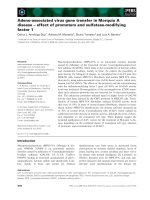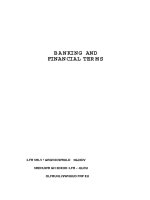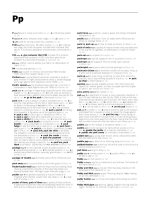PP 4 units of measurement and precision vs accuracy 1 3 4
Bạn đang xem bản rút gọn của tài liệu. Xem và tải ngay bản đầy đủ của tài liệu tại đây (1.06 MB, 42 trang )
Units of Measurement
Precision vs Accuracy
Sections 1.3 and 1.4
Types of Observations and
Measurements
We make QUALITATIVE observations of
reactions — changes in color and physical
state.
We also make QUANTITATIVE
observations that involve
MEASUREMENTS with numbers and
units.
NO NAKED
NUMBERS
A measurement always has two parts:
A value (this is the number)
A unit of measure (this tells what you
have)
Example:
200 meters; 15 ml; 13.98 grams
In Chemistry we use SI Units of measure
International System of Units
These are the base units that we will be
working with:
From these base units, we can combine them using
mathematical operations to obtain derived units.
Some of the derived units we will be using include:
Density (g/ml)
Area (m2)
Volume (m3)
Prefixes Used in the SI System
.
Metric Prefixes
Kilo- means 1000 of that unit
1 kilometer (km) = 1000 meters (m)
Centi- means 1/100 of that unit
1 meter (m) = 100 centimeters (cm)
1 dollar = 100 cents
Milli- means 1/1000 of that unit
1 meter (m) = 1000 millimeters (mm)
To convert from one metric unit to
another
remember
this
King–Henry
Died (Unexpectedly)
Drinking Chocolate Milk
pneumonic:
You must also know…
…how to convert within the Metric
System. Here’s a good device:
On your paper draw a line and add 7 tick
marks:
Next:
Above the tick marks write the
abbreviations for the King Henry
pneumonic:
k
h
d
(u )
d
m
l
g
Write the units in the middle under the “U”.
c
m
Let’s add the labels for
meter, liters, and grams:
k
h
d
hm
dam
kl
hl
kg
hg
km
u
d
c
m
m
dm
cm
dal
l
dl
cl
ml
dag
g
dg
cg
mg
mm
How to use this device:
1. Look at the problem. Look at the unit
that has a number. On the device put
your pencil on that unit.
2. Move to new unit, counting jumps and noticing the direction
of the jump.
3.
Move decimal in original number the same # of spaces and
in the same direction.
Example #1:
(1) Look at the problem:
56 cm = _____ mm
Look at the unit that has a number 56 cm
On the device put your pencil on that unit.
k
km
h
hm
d
dam
u
d
m
dm
c
cm
m
mm
Example #1:
2. Move to new unit, counting jumps and noticing the direction of
the jump!
Be careful NOT to count the spot you start from,
where you put your pencil point.
Only count the jumps!
k
d
c
dm
cm
km
h
hm
d
dam
u
m
One jump to the right!
m
mm
Example #1:
3. Move decimal in original number the same # of spaces and in
the same direction.
56 cm = _____ mm
56.0.
One jump
to the right!
Move decimal one jump to the right.
Add a zero as a placeholder.
Answer:
Example #2:
(1) Look at the problem. 7.25 L = ____
kL
Look at the unit that has a number.
7.25
L
k
h
d
u
d
c
m
On the device put your pencil on that
unit.
kl
hl
dal
L
dl
cl
ml
Example #2:
2. Move to new unit, counting jumps
and
noticing
the ddirection
of the
jump!
k
h
u
d
c
m
kL
hL
daL
L
dL
cL
Three jumps to the left!
mL
Example #2:
(3) Move decimal in original number
the same # of spaces and in the same
direction.
7.25 L = ____ kL
.007.25
Three jumps
to the left!
Move decimal to the left three jumps.
Add two zeros as placeholders.
Answer:
7.25 L = .00725 kL
Mass and Weight
•Mass and weight are directly related as long as we
remain on earth at the same elevation. That is, if one
object has twice the mass of another, then its weight on
earth would also be twice as large.
Mass and Weight
• Weight is force of the
gravitational pull on an
object (pounds, measured
with a scale). It would be
different on the moon than it
is on earth.
• Mass is a measure of the
amount of matter in an
object. (grams, measured
with a BALANCE)
What is a Liter??
Measuring
Volume:
measured with a
The volume of a liquid is
graduated cylinder.
When liquid is poured
into the cylinder, a curved
surface called the
meniscus is formed.
Learning Check
1. 1000 m = 1 ___
a) mm
b) km
c) dm
a) mg
b) kg
c) dg
2.
0.001 g = 1 ___
3.
0.1 L = 1 ___
a) mL
b) cL
c) dL
4.
0.01 m = 1 ___
a) mm
b) cm
c) dm
1. 1000 m = 1 ___
a) mm
a) mg
b) km
b) kg
c) dm
2.
0.001 g = 1 ___
c) dg
3.
0.1 L = 1 ___
a) mL
b) cL
c) dL
4.
0.01 m = 1 ___
a) mm
b) cm
c) dm
Measured Numbers
When you use a measuring tool is used
to determine a quantity such as your
height or weight, the numbers you
obtain are called measured numbers.








![Designation: C 471M – 96 METRIC - Chemical Analysis of Gypsum and Gypsum Products [Metric]1 ppsx](https://media.store123doc.com/images/document/2014_07/10/medium_jfk1405009249.jpg)
